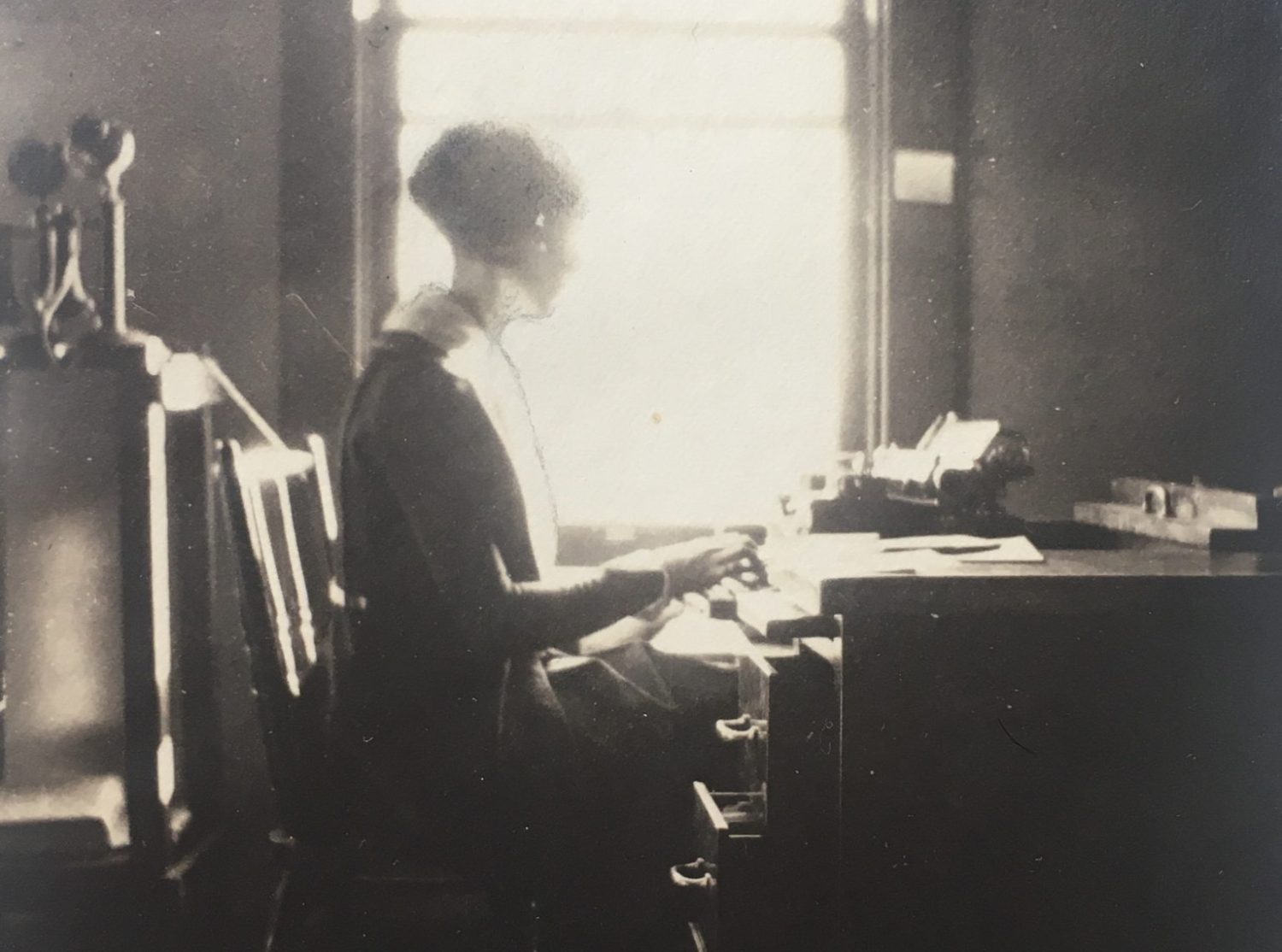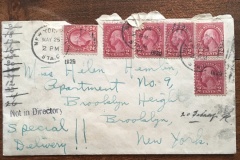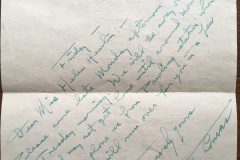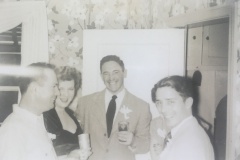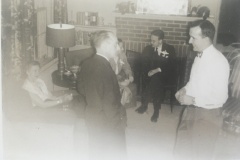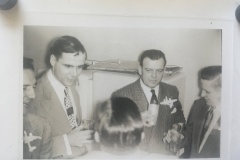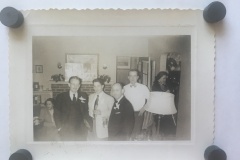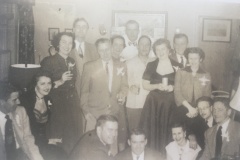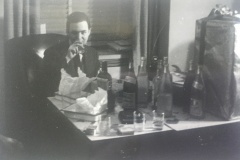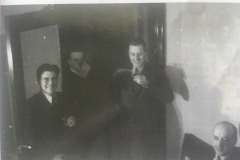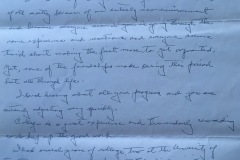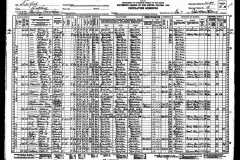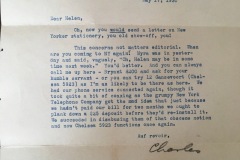All the Stories
While reading the first 100 letters from Mama to her daughter in my first 1,000-letters project, Running to Thousand Letters, I considered many stories. I was not only trying to understand the relationship between Louise Palmer and her mother, but also why it mattered to me, a complete stranger to them.
My leading story was that Mama wrote so many letters because she wanted to maintain control of and connection to Louise … emphasis on control.
I had found Mama’s directives about when and how Louise should do her laundry and how often Louise should write to her oppressive. I wanted Mama to let Louise live her own life.
But Louise didn’t appear to push back. If she did, Mama never wrote of it. And, I didn’t have Louise’s side of the letters to check her version of my story.
Reading a letter that revealed the death of Mama’s baby son caused me to melt for her. I never learned how ‘little son’ died. But I did learn how sad she and others who wrote letters of condolences were for her loss. The sadness led to an epiphany: Mama was not my mother. I had been looking through the filter of my own relationship with my mother and seeing it in Mama and Louise.
Ever since, I’m more aware of my filter. Its influence helps me recognize signals, like anger, that something else may be going on. To understand what was going on through letters from people long dead, I’m left to do my best to connect clues and consider why my reactions, my stories, are what they are.
That filter still pokes its roots from the ground and trips me. Each time, I’m humbled at the imperfect human that I am.
About Howell
The first writer in the collection to challenge me similarly was Howell. After Helen left New Mexico in August of 1928 and returned to New York, he wrote thirty-six letters to her from October 1928 through December 1929. He lived in Sante Fe, New Mexico, next door to Cathrene, Helen’s sister, and her husband, Charles Broome. Howell and Helen seem to have had a relationship that at least Howell perceived as romantic.
I disliked him from his first letter. I recognized immediately that my dislike for him might transform as had my dislike for Mama. Even though I was suspicious of those first reactions, I still voiced them. Sample replies to letters in Episode 8 included:
- “Why did he call her ‘darling little girl’? She’s in her late 20’s!”
- “Only gone a month and whine, whine, whine about how miserable his life is without her. Suck it up buttercup!”
- “Why is she continuing to write to this guy? All he cares about her presence so that he can suck happiness out of her.”
I ranted and stomped through the house before returning to another letter hopeful a more likable Howell would emerge. Each time I’d get more irritated. I perceived a manipulative, passive aggressive, miserable person.
But, was he? Or was my filter at work again?
There was something about this guy I didn’t like and I wanted his letters to end. Yet, I couldn’t look away from them or him because he kept writing. I wondered why Helen kept his letters. What was it that got under my skin?
I suspected what I wanted was more letters from my future grandfather, Charles. At the same time, I also had a hunch that that might not be exactly the root of what was bugging me. Into a natural pool I dove, unable to see the bottom.
All the Stories #1 – Helen’s New Mexico Interest was Family
By Episode 9, I had sifted through all my stories about why Helen, born and raised in Queens, New York, spent so much time in New Mexico in the 1920’s. Howell? College? Work at the First Savings Bank & Trust in Albuquerque? Her sisters: Catherine and Elsie?
Each of Howell’s thirty-six letters to her drew me closer and closer to a conclusion that he wrote of a love that he wanted to be, rather than a love that was. His lamentations over her lack of response reinforced my hypothesis. Further evidence included her sister Cathrene’s warning not to encourage Howell in her last letters before she died unexpectedly in July 1929. Helen’s attention to jolly letters from Charles and one from Lowell Thomas inviting her to join him as one of four writers on his staff at Clover Brook Farm (an offer she accepted) were what I believed sufficient evidence to support my story that New Mexico was about Elsie, Cathrene, and their families, not a romance with Howell.
Finally, after reading all the 1930’s letters, I concluded she was there because her sisters, Cathrene and Elsie, lived there. I also feared she may have avoided returning to New Mexico in the spring/summer of 1929, in part to sidestep any interaction with Howell, a decision she may have regretted after Cathrene’s death.
Or maybe, as one follower of the Another Thousand Letters YouTube series pointed out, Helen was sending him mixed signals. It was a powerful observation. Even though I wanted to believe my story that Helen was a decisive, independent, confident woman, it was possible she wasn’t sure to whom or even if she wanted to marry.
Episode 8’s ending surprised (and annoyed) me. Why had she agreed to let Howell take her on two dates over the holidays in December 1929?
By the first 1930 letter, it had been over a year since they’d seen each other. As I read it, I didn’t believe Howell’s words.
I am satisfied that if we were meant for each other we will have each other. And, on the other hand, if we were meant only to be dear friends it will be that.
Howell to Helen, January 13, 1930
All the Stories #2: Howell Tried Guilt on Helen
I imagined more stories. I also suspected Helen felt obligated for some reason to spend time with Howell or maybe like the suggestion above, she wasn’t clear about her feelings for him. Or, perhaps being a neighbor in Santa Fe, he was unavoidable and she didn’t want to disrupt neighborhood gatherings by having bad feelings between them?
I will likely never know. What I saw was Howell stretching every interaction, no matter how brief, to see Helen’s love for him, however unlikely. I was fed up with Howell when I perceived a guilt lever, not for the first time, to draw her attention:
Dear Helen, I received your short note from Washington and have been waiting for the long letter you were going to write when you got home. So far I have not received it and hope it has not been lost in the mail. I have been looking and expecting a letter from you for more than two months. I hope there has been nothing wrong and that it has been that you have been too busy to write. That is bad enough, but I don’t want anything to be wrong.
Howell to Helen, March 15, 1930
Grief Revisited
My irritation exploded.
Didn’t he understand what it was like for families dealing with the aftermath of sudden death!? I flashed back to the sleep-deprived months after funerals for Dad, Arlene, and her mother in the spring of 2018.
Multiple water problems complicated the logistics of emptying their home. We found rotten floors near the dishwasher, mildewed walls between the garage and laundry room, and what had been a beautiful pool transformed into a frog and snake resort. Each discovery of this home missing its caretakers was another reminder of death.
We four siblings were spread across the planet trying to make decisions about what to do with what in the midst of grief for them. Six months after they died, I felt everyone was doing their best to get along, even though we had disagreements. The decision of what to do with the house stagnated while the compost at the bottom of pool rotted. I couldn’t see new life forming out of sight. I waited and hoped a mutually agreeable consensus would emerge. (It did.)
It had not quite been a year for Helen since Cathrene died suddenly. She was working at a new job in New York, living with her mother, and had not been able to attend the funeral. At least we siblings had had time and resources for a memorial service for both Arlene and her mother as well as Dad. After the last year of Covid memorial services via video calls, I realize just how lucky we were.
Helen had neither and this was how Howell empathized?
About Anger
Fury is a good hint to slow down. I considered Howell selfish for what I perceived as assuming Helen’s time should be focused on him when she was likely suffering. It was easy to label him an inconsiderate, selfish jerk and dismiss him.
I paused remembering Mama. I had labeled her similarly. What was going on here?
Maybe, I also considered, my assessment of him was as misplaced as that which I had concluded for Mama. Did my reaction have anything to do with continued grief of losing Dad and Arlene so suddenly? It had been almost three years since their deaths. Was the grief still there?
Yes.
I missed Arlene. I missed impromptu calls that lasted hours, birthdays and holidays always remembered, and frequent demands to move back to Ohio. Now that would only occur in memory. I missed the person who would bring us together for the holidays and insist on midnight mass even though it was questionable whether anyone was sober enough to drive.
None of us had had time to reconcile the reality of her loss when Dad died too. In the present, I embraced gratitude that he died before I had time to hurt him with my misplaced belief that her death was his fault. Inexplicably, I remember thinking he died on purpose to divert the attention from Arlene, and her mother who had died four hours prior to her, to him.
Just like Howell’s every letter to Helen seemed to divert attention from her to his need for Helen’s presence to make him happy.
Hmmm. I always resented Dad’s behaviors toward Arlene’s priorities. She prioritized family first over him exclusively, a choice over which they’d disagreed for years.
But their decisions and disagreements were no more my issues than were the dynamics between Mama and Louise.
About all the Stories
As I slowed further, I considered:
If it hadn’t been for Dad quickly calling 911 after Arlene’s aortic dissection, she would have been dead days earlier.
Both he and Arlene were overweight, didn’t exercise, and had had multiple medical problems for years. Arlene smoked and was recovering from breaking her back the prior November. Dad had sleep apnea and snored so loud the house shook. He’d had several strokes and took medications to accompany his pacemaker.
Just the prior November, I’d been in Ohio because we thought he was dying. I’d never forget his stories. He’d conceived JellyFish tea that he believed would reverse aging. He said he saw Ginny’s husband Bob motioning to him beyond the hospital window to join him. Bob had been dead for decades. I believed as I had seen with my friend Marcy who died from pancreatic cancer in 2014 that he was signaling me. I expected he would be dead within a week, just like Marcy.
Appreciation for Howell?
For a sixteenth of an inch, I appreciated Howell. By stewing through his letters, my anger reduced to a different story: two of my favorite dishes would never be at the smorgasbord of a holiday dinner again. Only the flavor remained as I sobered up after binging on grief.
I didn’t regret one sip. I missed them both and I might not have noticed had I not emptied the bottle, ugly as the process revealed me to be.
As I slowed even further, I considered that Howell may simply have wanted his own closure. It seemed that whatever spark had been between he and Helen had been frozen by at least two winters.
About Actions
Helen’s actions spoke for her unwritten words.
She didn’t respond to the March 15th letter.
She didn’t respond to his March 31st letter, possibly because he’d forgotten her birth date for the 2nd year in a row.
Even though I’d softened a little for Howell, I hoped that was the end of him.
All the Stories #3: Writing at Clover Brook Farm
Helen was writing at this time.
Two letters from Gloria, her eight year old niece, who had just lost her mother, express her gratitude to Helen and her grandmother Katherine as well as to her paternal grandmother, Mae Broome, with whom she stayed in Memphis. Gloria anticipated that she and baby sister, Junie, would return to Santa Fe that summer and hoped Helen would join. I shared Gloria’s hope Helen would go. But I wondered if the possibility of seeing Howell caused her hesitation?
Gloria and others addressed their letters to Clover Brook Farm, Pawling, New York. After mapping the address, Google’s street view introduced me to what Helen might have seen. I enjoyed looking up under a tree canopy, a place Helen may have enjoyed too. Back in Episode 6, I read the letter that Lowell Thomas, who owned Clover Brook Farm, wrote to her in May, 1929, with what appeared to be her job offer.
About Clover Brook Farm
Clover Brook Farm was not only Lowell Thomas‘s home, it was also his home office, long before remote work trended. After purchasing the home in 1926, he built a broadcasting studio in a room of the home. I wondered if the unidentified writer photos from Episode 3 were of parties in that home.
When Helen began working for Thomas, he was sharing stories of his travels on the Sunday evening NBC radio network program Literary Digest. I wondered if Helen helped edit his July 1930 news story about his trip to Cuba. By October 1930 he had taken over hosting the show from Floyd Gibbons. Thomas evolved the program to focus on stories about others and began including news items, many of which Helen may have drafted and edited. [Reference: Wikipedia Article on Lowell Thomas]
Hopeful I’d discover names of the three writing companions to whom she referred in her August 1985 letter to me living at the farm as well, I pulled the 1930 census. I confirmed Helen’s address as Clover Brook Farm. But, I did not find the other three writers. Instead, I found Thomas, his wife, Frances, their son, Lowell Thomas Junior, and Henry and Anna Algermussen (not sure of spelling as it’s illegible), a butler and cook, respectively.
The names of the additional three writers at Clover Brook Farm remains an unsolved mystery as of this post.
All the Stories #4: Charles Harris Cooke
Whereas with Howell, I dreaded his letters, I read and re-read the 1930 letters from Charles. In February 1927, his reaction to Helen’s lack of attention to him was 180 degrees different from Howell’s with many more uses of “we” and a balanced focus on her.
Dear Helen, Thanks for your letter — I was wondering what had happened to you. I called up the other night and Myra told me you’d been in town the night before! – I gnashed my teeth. Be sure to call me up next time you plan to hit NY because I’ve no way of knowing when you’re going to be here. I want you to see our new shack – and we’ll feed you dinner – potatoes and carrots, or potatoes and spinach, or potatoes and baked beans, or carrots and potatoes, etc. We also have coffee. And one jellyroll, every pay-day.
Charles Cooke to Helen Hemlin (later Cooke), February 27. 1930
Charles closed by asking about her, her job with Lowell Thomas, and, most importantly to me, her writing. This endeared me to Charles. I quickly devour his next letter.
All the Stories #5: Stephen Crane, O. Henry, and Joseph Cooke
On April 23, 1930, Charles escaped the city to sooth his “jangled nerves” and spend time in his parents’ home in Cooperstown, New York. The letter didn’t say why his nerves were jangled. He shared stories of his medicine: walking along the lake, rough-housing with the three dogs, especially his favorite, and mine, the collie, and getting his Dad, Joe, to talk about writer friends and writing.
I imagined Helen reading the letter dropping into the stories, as I did, and wanting more. I wanted to know more about Great Grandpa Joe’s friendship with Stephen Crane, presumably Joe’s source of two original signed copied of The Red Badge of Courage. By the end of the letter the books had been sold to fund a relative traveling to the U.S. from England.
I wanted to know more about Joe’s friendship with writer O. Henry and how he came to finish two of Henry’s manuscripts after his death. Unable to resist, I pulled the Finding Aid for the O. Henry collection at the Greensboro History Museum. I had not read anything by O. Henry and was surprised to learn he spent time in prison for embezzlement. His short stories, Whirligigs and Sixes and Sevens, now public domain, were published posthumously.
I added an item to my “For Later” List. Was there a reference to my great grandfather, Joseph Cooke, in the original publications or any correspondence between him and O. Henry in the late 1890s?
I was thrilled to find another letter.
All the Stories #6: Bye-Bye or ‘Auf Revoir’ to Charles’ 1930 Summer Plans
I opened the brief May 17, 1930, letter typed on New Yorker stationary. The job must have come through and Charles’ summer plans gone bye-bye.
All the Stories #7: A Collie called “Wee”
In November 2012, I adopted our border collie, Scout. Terri Florentino of Shebaa Border Collies bottle fed the litter’s runt born at 5 ounces. Our black ball of fur with a white sock came to us as the ‘Wee One’ because of his size. I deferred my excitement for meeting him. First, I took a side trip to Cooperstown. I had not met a cousin, Hugh, who still lived there with his wife, Eleanore. I stayed at what is now the Inn at Cooperstown. For decades it had been the Cooke family home at 16 Chestnut Street.
In doing research for this post, I learned Henry J. Hardenbergh was the home’s architect. Coincidentally, he was also the architect for The Dakota apartment building in New York City. If you are current on Another Thousand Letters YouTube episodes, you will remember Episode 22 – Building, in which I featured The Dakota. Helen, with Russell Maloney, published The Dakota in the New Yorker, October 12, 1934, an article whose original research and draft is in my collection. (We’ll get to that in the Episode 22 blog post.)
Looking back at my stay at the Inn at Cooperstown while visiting with Hugh and Eleanore, I experienced why Charles’ nerves would have been soothed. I imagined him walking along Lake Oswego with his collies, playing the piano for hours, and enjoying what was a home and is now a spacious, beautifully restored Inn. It’s a place I hope to return someday to enjoy its many sitting areas for reading, writing, or listening to music.
All the Stories #8: Helen Couldn’t Avoid Howell
Two weeks after Charles’ letter to Helen, I was astonished to see another letter to Helen from Howell. Five months had passed since she’d written to him and she appears to have made a decision to leave Lowell Thomas and return to New Mexico.
It’s odd the way the mind works. I knew that Helen continued working for Thomas for three more years from Episode 3‘s obituary and that she wasn’t leaving New York forever. And, I also knew that Helen married Charles seven months later.
Yet, my anxiety still spiked. I wanted to know more about working for Lowell Thomas and her courtship with Charles. When was she coming back? Why did she reach out to Howell?
My mind made up a story. She must not have been able to avoid seeing him. Regardless of what she wrote, Howell was already convinced her visit was about seeing him. I was annoyed he addressed her as ‘darling,’ a term I decided nearly 100 years later, should only be for Charles. I conveniently forgot that it still didn’t appear from Charles’ tone that they were even dating yet.
Helen darling, I was surely glad to have your nice newsie letter. I received it Monday and have intended writing before this but … I am thrilled to death to hear that you are definitely coming out this summer. I am surely looking forward to it and I am sure we can have a grand time, at least I am sure I will enjoy it.
Howell to Helen, May 1930
I was surely convinced I did not want Helen to spend time with Howell.
All the Stories #9: New Yorker hires Vice President of Screwballs
The collection’s next letter gave me hope I need not worry that Helen and Charles would resume their relationship. Charles wrote to Helen on New Yorker stationary. The job came through and all his summer plans went bye-bye. He would be so busy being in charge of all the screwball stories, he’d have little time for more.
It’s a good time, I decide, for Helen to visit her family in New Mexico.
All the Stories #10: Helen starts for New Mexico with who?
A series of eight letters from Helen to her mother, Katherine, and Aunt Erne began with a man named Paul. Paul came out of nowhere and disappeared just as fast. Their train trip from New York and visit to Niagara Falls was the first stop on Helen’s two-week cross country trip toward New Mexico.
After seeing the Falls from every possible angle except the air, they boarded a boat to Detroit. After a late dinner, they danced and stayed up until 4 in the morning talking on the deck. Helen confided in her Mother and Aunt:
He is quite afraid of having a girl take him too seriously. It really was a wonderful night and we sealed a friendship that I probably never will be able to make with anyone else.
Helen writing the first of eight letters to her Mother and Aunt Erne, Summer 1930
The rest of the 1930 letters are for Episode 10. Enjoy Episode 9.
